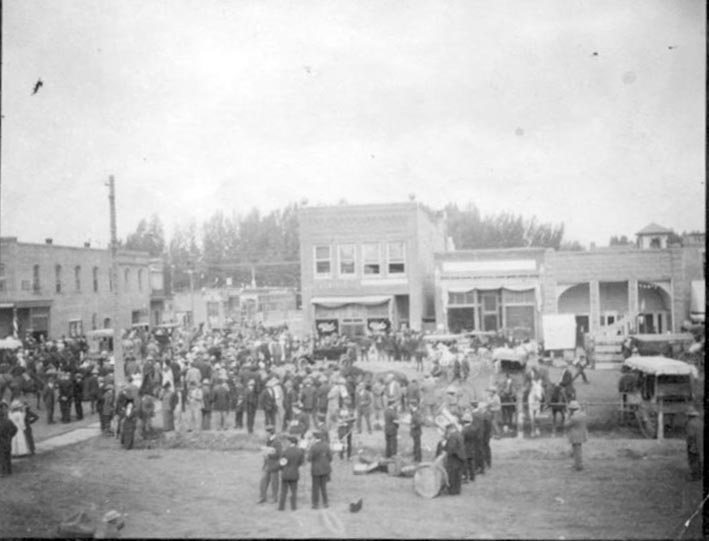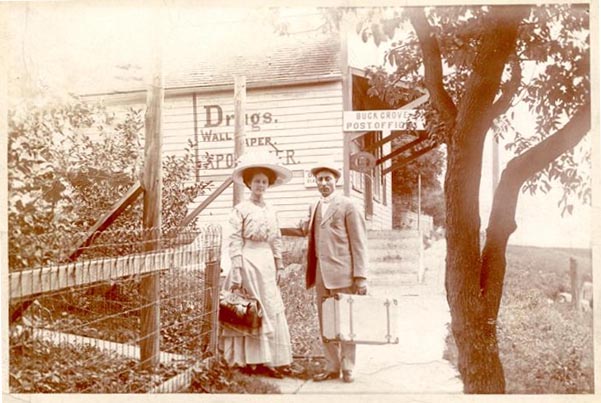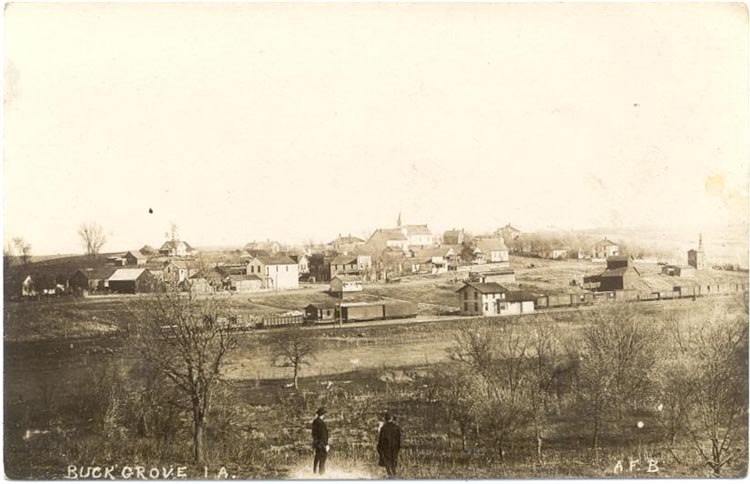Buck Grove History
from 1862
The Early Days, 1853-1887
About the 1st of May, 1853, John A. Dunham and Ambrose Richardson settled at Dunham's Grove. In June Rufus Richardson and D.J. Fowler, and in September, Clark Winans and B.F. Wicks settled at Mason's Grove; W.H. Jordan and J.R. Rudd at Lost Grove; R.D. Butterworth at Oak Grove; Judge John R. Bassett, John Gilbreath and Moses and Daniel Riddle at Coon Grove.
Mathias Didra, the first German settler in the county, located at Buck Grove. In 1854 the settlement at Mason's Grove received several new members. During the same year Mathias Didra erected a saw mill at Buck Grove.
Buck Grove Earns Its Name
In 1862 a little market town earned a spot in the center of Washington Township of Crawford County. The land around the town was used for farming and grazing cattle. It was also found to be a good hunting ground because of the many deer. Because of this, the town was named Buck Grove. This town was on the Sioux City branch of the Milwaukee Railroad and in many ways was an ambitious and thriving town.
During the early settlement there were approximately 75 people. The interest of these people led to a progressive and marketing future. The businesses on the Main Street gave many people their employment. There were 22 businesses found on Main Street during the early settlement. These businesses included two grocery stores, hotel, two saloons, dance hall, lumber yard, farm implement store, blacksmith shop, band, hardware store, two garages, two produce stations, two grain elevators, stockyard, hog buying stations, theater, drugstore, and post office.
Some early Irish settlers that came to Washington Township were Isaac Gilmore in 1869, John O'Leary and E. Moore in 1871. In 1870 the new township of Washington was formed and Nishnabotny was a part of it.
Prairie fires were a great menace and great losses were sustained in 1872. In October 1874 prairie fires swept nearly every part of the county and the damage caused was estimated to be thousands of dollars. There was a high wind and the old settlers claimed that they had never seen such prairie fires as on that day. At Dow City, Judge Dow lost one hundred tons of hay and the fire raged through Buck Grove and Coon Grove.
Buck Grove an Offical Town
On August 22, 1887 at 10:45 A.M., President J.F. Cary and secretary P.M. Meyers of the Milwaukee Land Company, filed the plat of Buck Grove at the Courthouse in Denison with the Recorder, John Seemann. The document gave a complete description of the town of Buck Grove and caused a survey to be made and a map to be drawn showing the six main blocks, laid out with streets, alleys, and individual lots.
After setting up businesses, the businessmen were also the founders of three churches. The people formed a Methodist Church built around 1890. The St. Joseph Catholic Church was started in 1888 by Father H. Byrne, pastor of the Sacred Heart Catholic Church of Manilla. Then 1904 saw the building of St. John's Lutheran Church started by Rev. F.O. Lothringer of the Zion Lutheran Church of Denison. The lots for the churches were owned by the Milwaukee Railroad Company, of which one was donated and one was purchased by the parish for the Catholic Church. The lot for the Lutheran Church was donated by Fritz Olsen. Transfers show the Methodist Church lot was purchased in 1890.
In 1897 Buck Grove was a town of about 125 people. The postmaster was Sam Moffitt who also had a general store with his son Robert. The building was 22 x 60 feet and he carried dry good, notions and groceries, also bought grain and livestock. The H.A. Quinn firm had one of their lumber firms in the community with O.M. Bicknell as manager. Fred Gigax's general store, 22 x 60, had dry good, notions, boots, shoes, men's furnishings and groceries. P.W. Gigax, the son of Fred, was the manager of the St. Paul and Kansas City Grain Company. This company had a large elevator in Buck Grove which could hold 10,000 bushels of grain. The machinery was run by steam engine. Mrs. Fanny Bonney had a drug store where she dispensed drugs, patent medicines, cigars, tobacco, candy, glass, paints, and oils. J.S. Williams owned the third general store, 24 x 30, where he sold dress goods, dry goods, hardware, groceries and country produce. Miss Lizzie Mitchell was the land lady of the hotel which had 10 to 15 rooms.
About this time single Indians and Indians in groups were soliciting money, provisions, or any old "hand me downs" especially in the Buck Grove and Deloit area. Among them was Yellow Smoke.
The 1900s
In 1900 Buck Grove assembled a baseball team playing surrounding communities. An estimated thousand people attended the Fourth of July celebration in that community.
4th of July celebration in Buck Grove
1902 was the year of Denison's first and greatest street fair. President Roosevelt was billed to be in the city for a short time on September 26th, but on account of a minor accident he was unable to make his western trip as planned. In spite of this disappointment the street fair was a great success. There were many fine attractions and two beautiful parades, one in the daytime and one at night. For the purpose of the parades a contest was held throughout the county for the selection of a carnival queen and for maids of honor from the various towns of the county. The contest excited much interest and came to a whirlwind finish at an amateur performance given for the benefit of the street fair. Miss Gigax of Buck Grove was one of the Maids of Honor.
The people were happy to see in the early 1900's that Buck Grove had sprung into a market town for the farmers around the community. Goods were shipped by the Milwaukee Railroad to the larger cities for the higher bids.
The people were concerned about education so they built a small school in which there were eight grades with approximately 15 students. School was held only in the winter months because children had to help with chores and cut wood during the other seasons. Most children progressed at their own speed learning to read, to write, and to solve arithmetic problems. Children would play marbles, build forts, and have snowball fights, climb trees and build tree houses during their recesses.
The teachers, which were hired, played an important role during this time besides teaching. They carried wood and cobs for the stove and made sure it was warm for the children in the school.
The population was about 100 with the three churches already mentioned. None had a resident pastor, however. George Carpenter had been the first postmaster, but by 1911 Mrs. A.F. Bonney was serving in that capacity.
The drug store and post office in about 1910.
The businesses in the town were represented by the following: Wm. Arndt and C.O. Whizing were merchants; Ben Quathamer sold hardware; Quathamer and Finnegan had a furniture store; J.P. Welsh was the blacksmith; The Farmers Lumber Co. employed H. Asmus as manager; James Hain was a wagon maker; D. Hemphill took care of banking needs; W.L. Morton was station agent; Mrs. M. Vogt ran the hotel; F. Bonney ran the drug store; John Finnegan was manager of the Neola Elevator Company; H. Neubaum was saloon keeper; Thos. McGuire was section foreman; Dr. A.F. Bonney was a man of much fame as a writer; and Joseph Brewster ran the livery stable and acted as town marshall.
In 1913 Buck Grove was given a road connecting to the county seat, using the old ridge road through Washington Township northeastward to the big Coon Grove hill, thence through the grove and northward to Denison.
The 1915 and 1916 Fires
In 1915, the Buck Grove livery barn owned by Joe Brewster was completely destroyed by fire. Five horses were burned to death. A large amount of hay, grain, and feed was consumed and also some harness. Three of the horses belonged to Brewster, and two to Henry Rick. C.F. Chase lost two purebred cattle, which were heavily insured. In addition Reiff and Hamer lost a building containing salt and feed.
Wells were pumped dry; then Quathamer opened his big cistern and directed the fire fighting work. Everybody worked with a will; even the women helped in the bucket brigade. Due to the neighborly effort, many of the citizens of Buck Grove saved their homes.
The following year a big fire destroyed the Asmus store, where it started. The fire spread to the Reiff-Hamer store, the pool hall, barber shop and hotel, destroying all of them. The bucket brigade saved the lumber yard and Quathamer's hardware, the only store left in town. It was a little out of the fire's path on the east side of the street. The businesses rebuilt and life continued in Buck Grove.
Effects of the Depression
The turning point in the little town came around 1932, when the banks were closed. As the businesses started to decline some of them sought green pastures elsewhere. One by one they left until there were only the gas station, general store, blacksmith's shop, Golden Nugget Lounge and City Hall left in the town. The elevators were either burned or torn down. Likewise the stock yards. The railroad ceased its service and the depot building was removed and remodeled into a home. Part of the lumber yard still stands as does the theater building and are used as storage. The dance hall remains and is used by the Golden Nugget Lounge. It was formerly a hardware store and a grocery store before that.
As everything improved so did the education, by the demand of the state. The country school started to fade in 1956, because the community wasn't able to meet the newer standards of education. So Buck Grove lost its small school and the rural schools of Washington Township are memories of the past. Washington Township has been divided between Dow City-Arion Community School and Denison School with the children living in Buck Grove attending Denison. Each school runs their buses past each country home so children no longer have the long walk to school that students in days gone by enjoyed.
Always the Railroad
The history of the railroad is parallel to other towns in the area which were also served by the Milwaukee. The period from 1866 to 1900 was one of steady growth. In 1881 a second railroad, the Milwaukee, reached the county. Colonel Hamilton said that when it came through only one third of the county was cultivated and land was selling for $10.00 an acre.
The Chicago, Milwaukee and St. Paul Railroad extended its line from Manilla through Buck Grove and west to Sioux City, crossing the Northwestern tracks in 1886 at what is now Arion. Regular trains began to run on the Milwaukee Road from Manilla to Sioux City by June of 1887. It took three and one half hours to run the 90 miles. There were two trains each way, except Sunday, when there was only one. If you wished to travel to Sioux City, you would leave Manilla at 6:30 A.M., reach Buck Grove at 6:42, Bell at 6:58, Kenwood at 7:07, Charter Oak at 7:22, Ute at 7:37, Mapleton at 7:59, and Sioux City at 9:50.
You will notice there was no stop in Arion where the Milwaukee tracks crossed the Northwestern. Citizens of Denison wanted a depot platform and a depot, a sheltered room 16 x 16 to accommodate passengers permitting people from Charter Oak, Bell, Kenwood, Buck Grove, Aspinwall, and Manilla to get to the County seat, Denison. Mail could be transferred also.
Incidentally the Buck Grove postmaster walked to Dow City every few days to take the mail out and bring in the new. He was getting tired of it and threatened to resign if a change was not made.
After due consideration the Commissioners decided that a large number of citizens of Crawford County would be greatly benefited by proper facilities for transfer from one road to the other at this crossing.
By the middle of February of 1888, the railroad crossing was being called Arion. An average of 20 passengers per day were changing cars there. Now people from Buck Grove and the surrounding area could get to the county seat or visit with relatives or friends by means of the railroad as other types of transportation were much slower, the other means being walking, horse back, or team and buggy.
A view of the railroad station and the town
In 1903 the station in Buck Grove was closed to freight and passengers. In 1979 the Milwaukee Road decided to cease operation through our town. On February 29, 1980 the last train made its way through our thriving metropolis. In December, 1980 the railroad was officially abandoned through Buck Grove to Sioux City and the tracks were take up or torn out. Gone forever was one of Buck Grove's historical belongings.
A brief history about Thew's Cheese Factory founded 1889 in Buck Grove and its founder S. M. Thew.
Source: The history of Buck Grove, Washington Township, on this page was extracted from their centennial book Buck Grove, Iowa, Centennial and History Book published for their centennial in 1987.
We thank Holly Ehlers for submitting this material.
Photos submitted by Gary Bicknell





